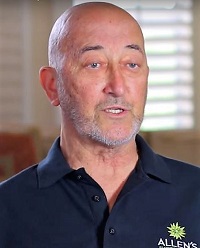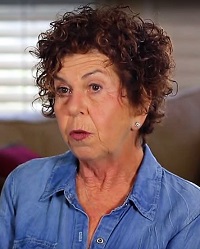Clinical trial giving patients hope in their fight against a devastating brain cancer

At a glance:
- University of Minnesota is offering hope for brain cancer patients through an innovative Phase III clinical trial led by Neurosurgery Department Head Clark C. Chen, MD, PhD
- Treatment combines injection of a virus genetically engineered to infect brain cancer cells and a drug designed to destroy virus-infected cells (developed by a company called Tocagen)
- The investigational treatment may avoid many of the toxic effects associated with traditional chemotherapies
- In a subgroup of brain cancer patients from a previous phase I/II study, one in five patients with expected survival of 4-9 months have lived three years or more after treatment.
Nancy Knop of Minneapolis, MN, and Max Levy of La Mesa, CA, are courageous healthcare pioneers, although they might not see themselves in that light. Having been diagnosed with a deadly, aggressive brain cancer, they’re doing everything they can to fight back and in doing so, to potentially help other patients.
Both Nancy and Max have glioblastoma, the same kind of brain cancer that recently took Senator John McCain’s life. Both have had multiple surgeries to remove cancerous brain tumors. Both have participated in other clinical trials to test new treatments. When their tumors recurred despite all their efforts, both decided to enroll in a clinical trial conducted by Tocagen that is testing an innovative therapy for this devastating condition.
“We decided to participate as soon as my doctor told us about the study,” Max said, who was diagnosed with glioblastoma in December of 2013. His wife, Marilyn, added, “When you’ve gone through the traditional ways to treat your disease and they haven’t been successful, you reach for anything that will give you life.”

Nancy (pictured at left), whose journey with glioblastoma began last July, was told about the U of M’s Tocagen trial being led by Neurosurgery Department Head Clark C. Chen, MD, PhD, by her neuro-oncologist, Elizabeth Neil, MD. Nancy’s 27-year career as a college track coach and Health and Human Kinetics professor at Ohio Wesleyan University helped her decide to participate. “Coming from a scientific background, I want to know – and want other people to know – that they have options,” she said. “I want to make sure that I’m living the best life I can and meeting all the right people who can help me figure things out.”
The treatment consists of a two-step process. The first step involves surgical resection of the tumor followed by injection of a genetically engineered virus called TOCA 511. This virus is designed to actively track and infect microscopic glioblastoma tumor cells remaining after surgical resection. “It is important to know that the injection of the genetically engineered virus after tumor resection is a surgical maneuver,” commented Chen. “Like all surgical procedures, the experience and expertise of the surgeon will impact the effectiveness of the treatment.”
About six weeks after the surgery, the patient starts taking an oral medicine called TOCA FC, an inactive form of a chemotherapy. This well-tolerated drug circulates throughout the body. When TOCA FC contacts the virus-infected glioblastoma cells in the brain, it is converted into a powerful anti-cancer drug that kills the cancer cells.
“Traditional chemotherapy also circulates throughout the body,” explained Chen, “resulting in side effects that compromise the quality of life for our brain tumor patients. In contrast, the innovative TOCA 511 and TOCA FC combination generates a high concentration of active chemotherapy only where it’s needed – in the brain cancer cell. Since there is no circulating chemotherapy, there is minimal toxicity.”
In addition to tumor cell destruction, the combination of TOCA 511 and TOCA FC retrains the patient’s immune system to fight off any residual tumors.


Max (pictured left) participated in a previous phase of the Tocagen trial led by Chen while serving as the Vice-Chair of Academic Affairs at the University of California, San Diego. Max has been cancer-free by MRI assessment for four years. Marilyn (pictured right) calls him the “Miracle Man.” Max’s recovery is nothing short of miraculous. “The treatment has enabled me to live a basically normal life,” he said. “There are certain things I can’t do as well since I’ve had my surgeries, but most things I can do.” Such as celebrate his 50th wedding anniversary and attend the bar and bat mitzvahs of his grandchildren. “Max was dancing his feet off,” laughed Marilyn.
“Glioblastoma patients whose tumors continue to grow after being treated with the standard chemotherapy and radiation do not typically do well,” noted Chen. “They have a life expectancy of four to nine months. This is the population we’re treating in the Tocagen trial.”
“We feel very fortunate to have this trial available to our patients,” Neil noted. “I view brain cancer as a locked door. We need to keep trying different keys until we find one that works. This study is evaluating a novel key and I’m hoping it’s the one that could benefit patients with this devastating disease.”
“In our previous study, one in five glioblastoma patients – whose expected survival is four to nine months – is living three or more years,” said Chen. “I think that many of these patients are effectively cured.” He added that generally, brain tumor treatments are not advanced to a Phase III status unless there have been compelling phase I/II results, such as with Toca 511 & Toca FC.
Family support has been key to both Max and Nancy. “I have a phenomenal family and incredible friends,” Nancy said. “They provide a strong support network.” Although optimistic, she is cautious about the future. “I can tell you from my heart that this isn’t the way I would have it,” she said. “At the same time, this is where I am. I get it. I hope I can stay here for a while and see what I can do.”
In Marilyn’s eyes, participating in the trial gave Max his life back.
In Marilyn’s eyes, participating in the trial gave Max his life back. “He has had a really positive outlook all along,” she said. “Max has talked to others about the Tocagen trial and tells them that it could possibly help. It may not work for everyone, but it just may work for you. Don’t give up hope.”
Chen has been treating glioblastoma patients using the TOCA 511 &TOCA FC combination since the inception of the original Phase I study and is an internationally recognized expert in this treatment. “It has been extremely gratifying to see many of my patients beat the odds with TOCA 511 and TOCA FC over the past decade of my study of this treatment,” he said.
If you have questions about participating in the U of M’s Tocagen clinical trial, please contact Felicia O’Neil at foneill@umn.edu.



